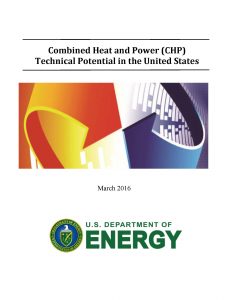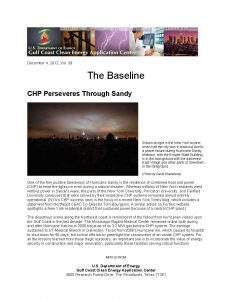CHP in the News
ACEEE Paper titled: Valuing Distributed Energy Resources: Combined Heat and Power and the Modern Grid, Published April 2018. This paper looks at how we value energy resilience/reliability and how to measure and value the energy resilience provided by CHP. To read the paper, Click Here.
Fuel Cell Use Grows Across the U.S.(Power Engineering 4/20/18) Read more.
Best Practices for CHP Development (Power Engineering 2/20/17). Read more.
Lochinvar & EC POWER Partner on Cogeneration Project for North American Market. Read more.
Complimentary copy of the 2018 Combined heat & Power magazine now available. Click Here.
CHP Installation Keeps Hospital Running During Hurricane Harvey. See story here.
While much of Houston, Texas, and the surrounding areas, were faced with uncertainty as Hurricane Harvey made landfall, the Texas Medical Center – the largest medical center in the world – was able to sustain its air conditioning, refrigeration, heating, sterilization, laundry, and hot water needs throughout the storm thanks to CHP.
Combined Heat and Power (CHP) Technical Potential in the United States
March 2016

This study considers both traditional “topping cycle” CHP and “bottoming cycle” or waste heat to power CHP (WHP CHP). Topping cycle CHP systems are the most common CHP systems currently in use. In a topping cycle system, fuel is first combusted to generate electricity. A portion of the heat left over from the electricity generation process is then converted into useful thermal energy (e.g. heating, hot water, or steam for industrial processes). A bottoming-cycle CHP system, which will be referred to as WHP CHP in this report, uses the reverse process. Fuel is first combusted to provide thermal input to industrial process equipment like a kiln or furnace, and the heat rejected from the process is then captured and used for power production.
The study discusses the typical industrial facilities and commercial buildings that support “topping cycle” CHP, “bottoming cycle” or waste heat to power CHP (WHP CHP), and district energy CHP. The goal of the report is to provide data on the technical potential for CHP in sufficient detail for stakeholders to consider combined heat and power in strategic energy planning and energy efficiency program design. Data are provided nationally by CHP system size range, facility type, and location. Each state’s technical potential is also delineated by these characteristics. download/read more.
 Hurricane Sandy proved CHP’s importance
Hurricane Sandy proved CHP’s importance
One of the few positive takeaways of Hurricane Sandy is the resilience of combined heat and power (CHP) to keep the lights on even during a natural disaster. Whereas millions of New York residents went without power in Sandy’s wake, the parts of the New York University, Princeton University, and Fairfield University campuses that were served by their respective CHP systems remained almost entirely operational. download/read more.
